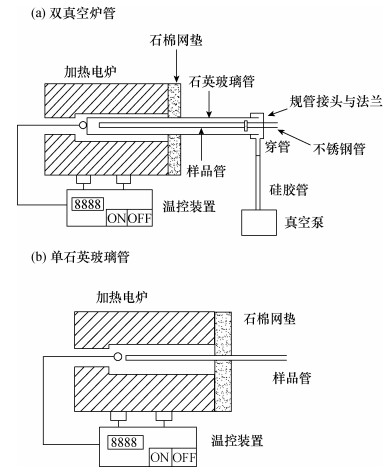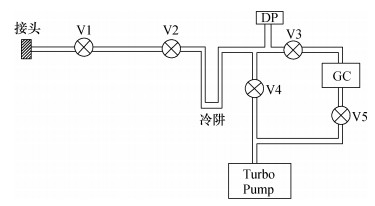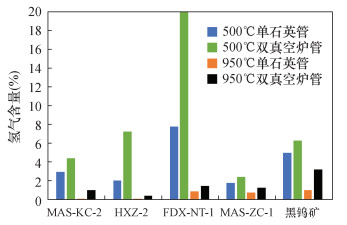Effect of Organic Matter in Water Samples on the Hydrogen Stable Isotope Ratio Determination by Thermal Conversion/Elemental Analysis-Isotope Ratio Mass Spectrometry
-
摘要: 在研究水文水资源方面,水中氢稳定同位素比值(δ2H)是一项重要的检测参数,它的变化规律可以用于识别和量化水分来源、揭示水循环演化过程及形成机理,因此促进了水中δ2H检测技术的发展。热转换元素分析同位素比质谱法(TC/EA-IRMS)测定氢稳定同位素具有高效、准确的特点,适合检测含有机物的水样。本文以乙醇为例,利用TC/EA-IRMS检测方法,探究水样中有机物含量对δ2H值的影响。通过配制不同体积比的乙醇-水溶液,测定溶液的δ2H值,建立了乙醇体积比与δ2H值的线性方程,相关系数(R2)可达0.9996,说明水样中有机物会使δ2H值产生线性变化,随着有机物含量增加,水样测定的δ2H值逐渐向有机物的δ2H值方向偏移。利用该线性关系在已知有机物δ2H值和体积比的条件下,可以对样品中H2O的δ2H值进行修正。以乙醇实验为例,其修正结果与真值的相对误差为1.7%,通过修正可以得到真实水样中水分子的δ2H值,有助于准确掌握水循环的状态和规律。同时,利用有机物与δ2H值的线性关系也可以对有机物进行溯源,在模拟溯源乙醇的实验中其溯源的δ2H值与真值相对误差仅为0.4%,说明该线性关系在有机物溯源方面具有良好的应用前景。要点
(1) 建立了水中氢稳定同位素比与有机物含量之间的线性关系。
(2) 实现了TC/EA-IRMS法测定含有机物水体δ2H值的修正。
(3) 将水中氢稳定同位素比与有机物含量之间的线性关系应用于有机物溯源。
HIGHLIGHTS(1) A good linear relationship was established between the content of ethanol in the water sample and the δ2H value.
(2) The δ2H value measured by TC/EA-IRMS can be modified via the linear equation.
(3) The linear relationship established can be used to trace organic matter.
Abstract:BACKGROUNDIn the study of hydrology and water resources, the hydrogen stable isotope ratio (δ2H) of water is an important detection parameter, and its changing patterns can be used to identify and quantify the source of water, and reveal the evolution process and formation mechanism of the water cycle. Therefore, the accuracy of δ2H value is very important, which promotes the development of isotope detection technology. High-temperature combustion pyrolysis-element analysis isotope ratio mass spectrometry is a highly efficient and accurate method for the determination of hydrogen isotopes. It is suitable for the detection of water samples containing organic matter.OBJECTIVESTo explore the influence of organic matter content in water on the hydrogen stable isotope ratio (δ2H) and establish a relationship curve between them. Use the relationship to modify the δ2H value of H2O and trace the organic source in organic polluted water.METHODSThermal conversion/elemental analysis-isotope ratio mass spectrometry (TC/EA-IRMS) was used as the main detection method. Ethanol water samples with different volume ratios (r) were prepared, and the δ2H values of the samples were determined by TC/EA-IRMS. Taking r and δ2H as variables, the curve relationship and equation were established.RESULTSA good linear relationship was established by using the ethanol content and the δ2H value as variable with R2 of 0.9996, indicating that the organic matter in the water sample will linearly change the δ2H value. As the organic matter content increased, the δ2H value measured by the water sample gradually shifted toward the δ2H value of the organic matter. Using this linear relation, the δ2H value of H2O in the sample can be corrected when the volume ratio of the organic matter is known. Taking the ethanol experiment as an example, the relative error between the corrected result and the true value was 1.7%. By correcting, the δ2H value of the water molecules in the water sample can be obtained, which helped to accurately understand the state and regularity of the water cycle. At the same time, the linear relationship can also be used to trace the source of the organic matter. In the ethanol experiment that simulated the traceability of the source ethanol, the relative error was only 0.4%.CONCLUSIONSThe linear relationship between organic matter and δ2H has a good application prospect in organic matter tracing. -
保存在幔源岩中的地幔流体挥发份的特征和性质与能源、矿产资源以及地球的演化过程密切相关,关于流体挥发份的研究是地球科学最为活跃的领域之一[1]。有关流体包裹体中挥发份(如CO2与H2O)含量的信息对火山过程和地球系统中各种元素的全球循环提供了重要的依据以及限制条件[2],熔体包裹体保存的熔体样品,为确定岩浆的挥发物含量和脱气行为提供了有价值的工具[3]。汤庆艳等[4]的研究表明,喷出岩、含硫化物矿床岩体中较高含量的H2说明岩浆起源于相对还原的流体介质中,且流体介质含有较多的H2O与H2,在喷发的过程中,岩浆不断散失,壳源物质混入,慢慢过渡到氧化性的流体环境中。
大多数固体物质在其形成的过程当中,都会从流体相中捕获微量的挥发性物质,可能的存在形式有:吸附于表面;化学束缚在固体内部;溶解在固体内;存在于不同类型的气液包裹体中。针对固体样品中所含气体成分的测试与分析,常用的实验方法可被归纳为两大类:无损检测法与破坏式检测法。
无损检测法包括显微冷/热台、原子吸收光谱、扫描电镜与能谱联用、红外光谱、激光拉曼光谱等[5-10],虽然这种检测方法对样品是无损的,但是仍然有各种各样的缺陷[11],如激光拉曼光谱所分析的包裹体需在一定尺寸内,并且是在透明矿物中,不能分析荧光矿物。而且岩矿样品的不均一性无法通过单个包裹体的分析得出一个平均的流体挥发份结果[12]。
破坏式检测法属于对岩矿样品内所含流体挥发份的群体性检测方法。经过破坏式检测法分析后的样品,已经与分析前不同。将岩矿样品脱出的气体导入气相色谱仪[13]或质谱仪[14-16]中仍然是行之有效的测试手段。破坏式检测法主要有两种:①热解法[17-20](又称热爆裂法);②机械破碎法[16, 21]。热解法,是将岩矿样品置于耐高温的炉管中,对其进行加热,使包裹体内的气液形成较大的压力,进而从包裹体中被释放出来。在高温热解的过程中,释放出的气体彼此间会发生一定的反应,而张铭杰等[22]认为,反应后的气体是原地幔流体平衡态的恢复,对恢复后的气体进行检测是平衡态的真实组分。上述实验方法中任何一种方法的进步,以及多种方法的组合使用,均有助于对相关科学问题的理解。
盛样管多使用石英玻璃管[4, 14, 23-25]。石英玻璃管有诸多的优点:石英玻璃具有极低的热膨胀系数,高的耐温性,极好的化学稳定性,与包裹体内常见的N2、H2、CO、O2、CO2以及烃类气体不发生反应。但是石英玻璃管仍然有不可忽视的缺陷,其结构中有很多不规则的空隙,使很多气体可能进行扩散和渗透。虽然石英玻璃可以用在高温高真空装备中,但是如果在热解法脱气的实验中,将其直接用作盛装样品的炉管,岩矿样品脱出的气体与周围的空气仅仅隔着一层石英玻璃管壁,那么两者之间就有可能发生气体交换,而脱出的气体成分又与大气组分有着明显的不同,任何微量的气体交换都有可能误导研究人员对实验数据的分析。针对这种可能存在的情况,应采用其他方法来盛装样品,并设计对照试验来确定气密性的优劣。
在检测岩矿样品稀有气体同位素的实验中,热解法常用到的一种装样加热装置是钼、钽坩埚组成的双真空炉[16, 18-20],这个装置是使用钼材质坩埚作为内胆盛装样品,钽坩埚作为外胆,套在钼坩埚外部,在线抽真空加热。钼的气密性很好,在常温下化学性质稳定,但在高温下会被迅速地氧化,所以需要处在真空的环境下被加热。此装置体积较为庞大,不易于移动、组装和拆解,且容易损坏[19]。
针对单石英玻璃管可能存在的气密性问题以及钼、钽坩埚组成的双真空炉存在的缺点,本文研制了一种石英玻璃与金属材质零件组成的双真空炉管,采用此炉管进行了岩石矿物样品的加热脱气检测气体组分的实验,确定了新研制的双真空炉管的气密性优于单石英玻璃管,且体积较小、易于移动、组装和拆解。
1. 双真空炉管的设计
本课题组研制的一种双真空炉管已申请专利(专利号201820953683.6)。仪器设备以及其管线系统的描述,可参考李立武等[11]以及专利(专利号为ZL201410746067.X)。研制的双真空炉管的主要部件包括:带有不锈钢穿管的KF穿管法兰、带有不锈钢旁穿管的规管接头、世伟洛克公司的U-Torr联接器、作为外管的石英玻璃管(较大)以及盛装样品的石英玻璃管(较小)。
使用时,将带有KF法兰盘的不锈钢管的一端与已有管线系统的进样口相连接,不锈钢穿管的另一端通过U-Torr联接器与样品管相连接,使用已有管线系统的真空设备对样品管内部抽真空。在样品管外部,使用石英玻璃外管以及相应的规管接头和KF法兰作为外管,连接真空泵,确保样品管在真空环境下工作,由此构成双真空。加热装置为一个中空的圆柱形电炉,使用时将炉管置于其内加热。
与前人所研制使用的钼、钽坩埚组成的双真空炉管[16, 18-20]相比,本文所研制的双真空炉管采用了金属与非金属组合的设计思路,且作为外管所使用的石英玻璃管较钽坩埚价格低廉;而盛样管更换时较为便捷,只要盛样管的外径符合U-Torr联接器的标准,定制的石英玻璃材质的盛样管与金属材质的盛样管均可以方便地进行更换。
2. 实验部分
2.1 实验样品
根据文献[1, 4, 26]所述,本次实验选取了一些火成岩样品进行实验,而汤庆艳等[26]对目标地质体进行研究时,指出了喷出岩、侵入岩以及矿床样品流体挥发份的变化。所以本次实验也选择了1个安山岩(喷出岩)样品(来自拉萨南缘地块叶巴组):HXZ-2。3个侵入岩样品,包括2个二长岩样品(来自马鞍山市的南山铁矿坑附近):MAS-KC-2,其中斜长石含量为50%,钾长石含量为37%;MAS-ZC-1,其中斜长石含量为45%,钾长石含量为30%和1个闪长岩含量样品(来自小岭地区):FDX-NT-1,其中斜长石含量为65%,钾长石含量为10%,角闪石含量为25%。1个矿床样品(来自赣南茅坪钨矿):黑钨矿,以及1个花岗岩样品(来自湖南省东部,属于印支期花岗岩):FRS。
岩石的鉴定数据由廊坊市地科勘探技术服务有限责任公司提供。除黑钨矿样品以外其余4个样品,均使用新鲜的部分破碎到40~60目。
2.2 实验操作
称取岩石样品0.2~0.6g,将其放入石英玻璃样品管内,通过世伟洛克公司的U-Torr联接器与进样口连接,移动加热电炉使石英玻璃管盛装样品的部位处于加热电炉的中心处加热,如图 1b中所示。实验开始时,图 2中阀门V1、V2和V4为开,V3、V5为关,将炉温设到100℃,抽真空去除样品表面的吸附气以及样品管内的空气,加热时间持续1h左右。待真空计(图 2中DP)的读数达到实验要求后,关闭V1, 将炉温设为500℃,加热30min,使气体从样品中脱出。30min后, 关闭V4,打开V1,将脱出的气体放入管线中。在冷阱处套上保温杯,杯内装有液氮酒精,液氮酒精的温度约为-60℃,将样品中H2O的冷冻在冷阱处。开V5等1min,关闭V5、V1。开V3,等待30秒,关闭V3,气体进入气相色谱计(图 2中GC),开始分析。分析时,打开V1、V4抽真空,待真空计的度数达到实验要求后,关闭V1,将炉温设为950℃,加热30min,重复上述操作。
使用双真空炉管的操作步骤与上述内容一致,只是将石英玻璃管换成双真空炉管(如图 1a中所示)进行操作。以此来研究探讨单石英玻璃管与双真空炉管在500℃以及950℃时的气密性。本次实验使用的样品管为石英玻璃管和钼管,在盛装样品前将石英玻璃管与钼管预先加热至1000℃,防止其本身在高温下脱出的气体干扰实验结果。本次实验采用的石英玻璃管与汤庆艳等[4]、Huang等[27]采用的石英玻璃管一致。
3. 结果与讨论
3.1 对照实验的结果分析
实验结果在表 1中列出,气体含量百分比是根据气相色谱仪测定的结果,将每个气体的色谱峰面积除以总色谱峰面积得出的。通过对5个样品的加热脱气实验数据的整理,气相色谱仪针对气体的分析主要包括H2、O2 +Ar、N2、CH4、CO、CO2以及C2H6、C2H4和C3H8等气体。C2H6、C2H6和C3H8等气体的含量很低,故在表格中没有列出。
表 1 各样品脱出气体的组分含量百分比Table 1. Percentage of component content for gases released from each sample样品编号 加热温度(石英管类型) 样品质量
(g)气体含量百分比(%) H2 O2+Ar N2 CH4 CO CO2 MAS-KC-2 500℃(单石英管) 0.3817 2.944 0.233 0.336 0.692 6.211 88.657 950℃(单石英管) 0.3817 0.044 0.295 2.748 0.054 0.382 94.875 500℃(双真空炉管) 0.3813 4.487 0.086 0.214 5.439 5.210 82.006 950℃(双真空炉管) 0.3813 0.982 0.142 1.619 0.837 2.240 93.891 HXZ-2 500℃(单石英管) 0.6384 2.035 0.448 1.040 21.009 5.016 68.313 950℃(单石英管) 0.6384 0.034 0.004 0.274 0.049 0.389 99.121 500℃(双真空炉管) 0.6369 7.351 0.186 0.420 10.186 1.873 75.907 950℃(双真空炉管) 0.6369 0.403 0.029 0.367 0.196 1.244 97.641 FDX-NT-1 500℃(单石英管) 0.5313 7.813 0.425 1.588 5.860 4.184 72.103 950℃(单石英管) 0.5313 0.860 0.004 0.044 0.078 14.796 84.096 500℃(双真空炉管) 0.5300 20.33 0.479 1.119 19.962 4.363 48.435 950℃(双真空炉管) 0.5300 1.465 0.014 0.034 0.623 14.542 83.126 MAS-ZC-1 500℃(单石英管) 0.2402 1.770 0.008 0.022 3.126 15.028 76.591 950℃(单石英管) 0.2402 0.754 0.116 0.452 0.200 0.982 96.897 500℃(双真空炉管) 0.2391 2.428 0.026 0.057 4.316 10.795 82.027 950℃(双真空炉管) 0.2391 1.292 0.148 0.637 0.587 1.219 94.911 黑钨矿 500℃(单石英管) 0.9403 5.016 0.032 0.265 0.785 9.341 84.328 950℃(单石英管) 0.9403 0.991 0.282 2.587 0.077 4.747 89.863 500℃(双真空炉管) 0.9398 6.391 0.070 0.439 3.242 1.454 74.501 950℃(双真空炉管) 0.9398 3.203 0.126 1.426 5.545 22.298 65.621 用两种炉管高温加热的实验中,脱出的气体在管线中的压强最小为100Pa左右,最高可达到1850Pa。在空白实验的过程之中,脱出的气体仅为3Pa至7Pa,气体进入仪器检测后,其总峰面积比加装样品后的总峰面积约低2~3个数量级(此处省略实验数据)。为了确定样品具体的释气量,在实验室所处环境下(温度约21℃,海拔约1500m)用针管抽取100μL空气,注入管线中,经多次试验,得出每100μL空气在管线中的压强约为290Pa。根据此对应关系计算得出每次实验样品脱出的总气量,样品质量同表 1。
岩石矿物样品脱出的气体中,H2来源可能有多种,王广等[24]已作了归纳和总结,观察表 1中的H2的百分含量可以发现,对于同一样品,使用单石英玻璃管时H2的百分含量均低于使用双真空炉管时H2的百分含量。
O2 +Ar、N2的含量很低。O2的含量低可能是由于在高温下H2与O2反应生成了H2O,导致O2的含量很低,但是对照实验是在同样的加热温度与时间下进行的,所以可以近似地认为样品加热脱出的H2与O2反应在两次实验中是均等的。同时根据N2含量较低可知,系统的真空密封性好,所以O2的含量也很低,如果系统的真空密封性较差,空气中大量的O2进入,H2可能与O2持续反应而使H2的含量低于仪器的最低检测限。
在含碳组分中,含量最高的是CO2,已有学者报道了岩石矿物中的流体包裹体在激光拉曼光谱检测下的主要成分为CO2和H2O[27-29]。纯化样品会破坏内含物[11],所以本次实验的样品没有使用任何溶剂清洗[16],这就导致了本次实验中,含碳组分的来源至少有两种:一是样品中流体包裹体在高温下爆裂,释放出CO2和CO;二是全岩样品基质中的碳酸盐在高温下(950℃)分解产生CO2和CO[30]。观察表 1中CO2和CO的的数据可知,在单石英玻璃管与双真空炉管中加热的样品,其CO2和CO的百分含量有时会有较大差别,尤其是作为主要成分的CO2也会有较大的不同。如闪长岩样品FDX-NT-1在500℃时CO2的百分含量以及黑钨矿在950℃时CO2的百分含量均有较大的不同。造成这些结果的原因至少有两点:一是岩矿样品本身的不均一性导致的。如果样品的均一性较好,在同样的加热温度与时间条件下,加热脱气过程中流体包裹体释放的气体、碳酸盐和痕量有机质在高温下的分解应该是一致的;二是样品的质量不同造成的。虽然在实验过程中尽可能保持同一样品在两次实验中的质量一致,但仍有细微差别,而且也没有清洗,质量较大的样品,其多出的部分所含的含碳组分的热分解会对最后的结果产生较大的影响。从而使CO2和CO的百分含量有比较大的不同,虽然热解法产生的CO2要大于破碎法产生的CO2[12],但是将样品清洗以后,CO2的含量会低很多[14]。而对于黑钨矿样品,单矿物表面可能粘结有次生碳酸盐以及后期蚀变部分,这些也会对CO2的百分含量造成一定影响[25]。以上所述关于CO2百分含量差异较大的可能原因,同样适用于解释CH4百分含量变化较大的现象。样品中痕量有机质在高温下也会发生变化或分解,产生CH4。CO有可能是样品中本身存在的,其他组分发生二次反应也会产生一定量的CO[22]。
表 2 各样品在不同温度点释出的气体量Table 2. Amount of gas released from each sample at different temperature加热脱气炉管及温度 气体量(μL) MAS-KC-2 HXZ-2 FDX-NT-1 MAS-ZC-1 黑钨矿 500℃(单石英管) 330.34 34.14 16.03 532.76 260.34 950℃(单石英管) 29.31 541.38 582.76 86.21 34.48 500℃(双真空炉管) 268.97 208.97 66.20 379.31 270.67 950℃(双真空炉管) 127.59 406.90 637.93 60.69 98.97 流体包裹体中可能存在的H2O是研究的重要组成部分,关于在这套装置下检测的H2O方法有两种[11]:一是通过总压强减去其他组分的分压强;二是在冷阱处收集H2O,在其余组分测试完毕,将管线内其余气体抽去,移去冷冻剂,加热此冷阱,观察此时的压强。但是真空管线会吸附H2O,所以还要在以后的试验中考虑新的方法来更准确地检测H2O。虽然Severs等[31]指出了激光拉曼光谱在测定H2O时会引起H2O的损失,但采用激光拉曼光谱[28]或红外光谱[32]来检测分析其中的H2O依然是较好的选择。
3.2 双真空炉管的真空密封性
针对前文中提到的单石英玻璃管可能存在的气密性问题,参照实验结果可得知,样品脱出的气体各成分含量与空气中的各成分有较大的不同,H2的含量比空气高,而O2与N2的含量要远远低于空气。H2、He和Ne这些分子直径较小的气体比较容易透过高温下石英玻璃不规则的空隙,本次实验中,并没有检测到He和Ne,H2的百分含量可以反映装置的气密性,参照图 3中的H2含量,可以发现5个样品在500℃和950℃时H2的百分含量,双真空石英炉管中的H2含量均高于单石英管中的H2含量。
本次实验中,图 1中所示穿管、真空管与真空泵使石英玻璃管(内管)在加热过程中处于真空环境下,减少了石英玻璃管(内管)管壁两侧气体的压强差,所以H2的扩散降低,更多的H2被保存在管内,随后被导入管线系统与气相色谱仪中。
通过对地质体的合理采样与实验分析,可得到岩浆矿床的形成机理与演化过程[4]。流体相的比值,如H2/H2O,其值与温度变化无关,可指示地质的氧化还原条件,用RH值来表示,RH=log(XH2/XH2O)[4]。根据图 3中的H2百分含量可知,如果加热脱气装置的气密性较差导致H2减少,那么RH的值可能有极大的不同,导致对实际氧化还原环境错误的判断。
3.3 双真空炉管以钼管为内管的试验
在检测稀有气体同位素组成实验中,加热法常使用钼、钽坩埚以及其他设备组成的双真空炉[16, 19-20]。He、Ne和Ar与钼在高温下不发生反应。之所以在岩矿样品高温脱气的组分实验中没有首先使用钼材质样品管,主要是由于钼在高温下会与某些气体发生反应:
2MO+3O2→2MOO3
2MO+2CO→2MOC+O2
MO+3CO2→2MOO3+3CO
MOO3+CH4+H2→MOC+3H2O
为了验证以上反应是否会较大程度地影响组分测试的结果,安排了以下实验。
根据前文第1节所述,本文研制的双真空炉管的内管具有可更换的特点,内管的外径符合U-Torr联接器的接口,定制合适的石英玻璃管或金属管均可进行更换。将花岗岩样品FRS,置于石英玻璃管与定制好的钼管中(均为双真空),按照前述的步骤进行实验。在500℃时,石英管内的样品释气量为270Pa(约93.1μL),而钼管内的样品释气量为106Pa(约36.55μL);在950℃时,石英管内的样品释气量为795Pa(约274.13μL),而钼管内的样品释气量为149Pa(约51.38μL)。可以看出钼管中的释气量更低,但是并不能确定一定是由于气体与钼发生了反应,所以决定更改前述中的实验步骤来进一步确定:在加热脱气的过程中,将V4关闭,在冷阱处加上液氮酒精,打开V1,此操作可以使加热脱出的气体尽快地离开钼管,进入管线中。经此操作,在500℃时,钼管内的样品释气量为322Pa(约111.03μL),在950℃时,钼管内的样品释气量为413Pa(约142.41μL)。由此可见,在500℃时,如果脱出的气体在加热过程中封闭在钼管中,也会与钼管发生反应,在950℃时的反应要更剧烈一些;如果将气体导入管线中,在500℃时,虽然释气量没有发生太大的变化,但是组分百分比差别较大,而在950℃时,释气量介于前两者之间,组分含量依旧不确定(表 3)。
表 3 重复性测试以及钼管试验结果Table 3. Repeatability test and Mo-tube test results样品 加热温度
(℃)样品质量
(g)气体含量百分比(%) H2 O2 +Ar N2 CH4 CO CO2 FRS
(11月21日)500 0.3352 25.252 0.346 2.351 24.638 9.076 36.767 950 0.3352 25.830 0.143 2.931 9.049 46.980 14.790 FRS重复
(11月25日)500 0.3357 27.832 0.333 2.433 22.901 7.848 33.761 950 0.3357 25.503 0.142 2.966 12.586 41.506 16.573 FRS钼管
(不开V1)500 0.3277 4.603 0.236 1.120 12.881 21.280 57.422 950 0.3277 14.077 0.361 2.467 10.026 22.534 43.388 FRS钼管
(开V1,关V4)500 0.3374 7.098 0.229 1.515 15.918 15.943 53.892 950 0.3374 10.939 0.264 7.122 9.996 41.897 23.739 尤其是岩矿样品中某些包裹体的主要成分为CO2,被检测物质与装样容器之间会发生反应,虽然钼管较石英玻璃管可能具有更好的气密性,但是在岩矿样品加热脱气检测气体组分实验中,不能用此材料作为样品管。孙明良等[19]指出了钼、钽坩埚的损坏问题,在样品量较大时,仅一次加热脱气就会使钼、钽坩埚烧穿或粘结,在本次实验中,观察到的现象也可以从某种程度上解释为什么钼、钽坩埚容易损坏,即钼坩埚壁因反应破损,加热熔融的样品透过破损处,进入钼、钽坩埚之间,冷却后使其发生粘结。
3.4 双真空炉管的重复性测试
由第3.3节中的讨论可知,在岩矿样品加热脱气检测其气体组成实验中,不可采用钼管作为双真空炉管的内管,所以在此装置的重复性检测中,仍采用石英玻璃管作为盛装样品的内管。使用花岗岩样品FRS进行装置的重复性测试,在11月21日与11月25日的两次测试结果列于表 3中,可以看出,同一样品在不同时间的分析结果的重复性较好。
4. 结论
本次研制的双真空炉管,应用于岩石矿物样品加热脱气的气体化学组成实验中,证明了在高温下,其真空密封性要优于单石英玻璃管,而钼材质不适于作为该实验中盛装样品的样品管。本装置应用于热液矿床样品及一些火成岩样品,检测出的主要成分是岩石脱气常见的成分,为相关研究提供了气体化学组成的信息。本装置在高温下的气密性更好,实验数据更加可靠,可获得更贴近实际地质情况的结论。
气体化学、稳定同位素以及稀有气体同位素组成是气体地球化学研究的主要手段,本装置的结构简单、便于组装与拆卸,可以方便地与稳定同位素质谱计以及稀有气体同位素计联接,开展岩石中气体的地球化学特征的相关研究。但相较之下,Bekaert等[17]可将样品加热至1300℃,而Blamey[16]研究中所用装置的最高加热温度为2000℃,本研究中所采用的电阻丝加热炉的最高加热温度较低,这是需要改进之处。
-
表 1 不同乙醇体积比水样的配制
Table 1 Detailed information of samples with different concentrations of ethanol
待测水样编号 乙醇体积
(μL)水体积
(μL)r=乙醇体积/
(乙醇体积+水体积)S1 0 1000 0 S2 10 990 0.01 S3 50 950 0.05 S4 100 900 0.1 S5 200 800 0.2 S6 500 500 0.5 S7 1000 0 1 表 2 标准水样δ2H的测试结果
Table 2 Measrued δ2H values of standard samples
标准物质编号 标准偏差
(‰)δ2Hst-s平均值
(‰)δ2Hst标准值
(‰)GBW04458 0.65 271.4 -1.7 GBW04459 0.79 200.1 -63.4 GBW04460 0.47 102.5 -144.0 注:标准偏差和δ2Hst-s是由5次平行测定结果求得。 表 3 不同乙醇体积比(r)水样δ2H的测试结果
Table 3 Measrued δ2H values of water samples with different ethanol volumetric ratios (r value)
待测水样编号 标准偏差
(‰)δ2Hsam-s平均值
(‰)δ2Hsam计算真值
(‰)S1 0.53 213.7 -50.9 S2 0.53 212.9 -51.6 S3 0.53 205.4 -57.9 S4 0.32 194.9 -66.7 S5 0.25 176.2 -82.4 S6 0.26 114.7 -134.2 S7 0.21 8.5 -223.5 注:标准偏差和δ2Hsam-s是由3次平行测定结果求得。 -
胡海英, 包为民, 王涛, 等.氢氧同位素在水文学领域中的应用[J].中国农村水利水电, 2007(5):4-8. http://www.wanfangdata.com.cn/details/detail.do?_type=perio&id=zgncslsd200705002 Hu H Y, Bao W M, Wang T, et al.Application of hydrogen and oxygen isotopes in hydrology[J].China Rural Water and Hydropower, 2007(5):4-8. http://www.wanfangdata.com.cn/details/detail.do?_type=perio&id=zgncslsd200705002
刘澄静, 角媛梅, 刘歆, 等.基于氢氧稳定同位素的哈尼水稻梯田湿地水源补给分析[J].生态学杂志, 2018, 37(10):3092-3099. http://d.old.wanfangdata.com.cn/Periodical/stxzz201810029 Liu C J, Jiao Y M, Liu X, et al.Analysis on water supply of Hani Rice Terrace wetland based on stable hydrogen and oxygen isotopes[J].Chinese Journal of Ecology, 2018, 37(10):3092-3099. http://d.old.wanfangdata.com.cn/Periodical/stxzz201810029
马建业, 孙宝洋, 马波, 等.纸坊沟流域水体氢氧同位素特征及其水量交换研究[J].水文地质工程地质, 2018, 45(5):24-33. http://d.old.wanfangdata.com.cn/Periodical/swdzgcdz201805004 Ma J Y, Sun B Y, Ma B, et al.Characteristics of hydrogen and oxygen isotopes and water exchange in the Zhifanggou watershed[J].Hydrogeology & Engineering Geology, 2018, 45(5):24-33. http://d.old.wanfangdata.com.cn/Periodical/swdzgcdz201805004
Tipple B J, Jameel Y, Chau T H, et al.Stable hydrogen and oxygen isotopes of tap water reveal structure of the San Francisco Bay Area's water system and adjustments during a major drought[J].Water Research, 2017, 119(1):212-224. http://www.wanfangdata.com.cn/details/detail.do?_type=perio&id=8cedf76ae8660d0b615ed12ff142ae28
Felstead N J, Leng M J, Metcalfe S E, et al.Unders-tanding the hydrogeology and surface flow in the Cuatrociénegas Basin (NE Mexico) using stable isotopes[J].Journal of Arid Environments, 2015, 121:15-23. https://www.sciencedirect.com/science/article/abs/pii/S0140196315001196
杨承帆, 杨守业.真空抽提结合同位素分析技术研究风化剖面中水的氢氧同位素组成特征[J].岩矿测试, 2016, 35(1):69-74. doi: 10.15898/j.cnki.11-2131/td.2016.01.012 Yang C F, Yang S Y.Using vacuum extraction-isotopic analysis technology to study hydrogen and oxygen isotopic compositions of water extracted from weathering profile sediments[J].Rock and Mineral Analysis, 2016, 35(1):69-74. doi: 10.15898/j.cnki.11-2131/td.2016.01.012
Mix H T, Chamberlain C P.Stable isotope records of hy-drologic change and paleotemperature from smectite in Cenozoic Western North America[J].Geochimica et Cosmochimica Acta, 2014, 141:532-546. https://www.sciencedirect.com/science/article/pii/S0016703714004700
邓文平.北京山区典型树种水分利用机制研究[D].北京: 北京林业大学, 2015. http://cdmd.cnki.com.cn/Article/CDMD-10022-1015319230.htm Deng W P.Water Use Mechanism of Typical Tree Species in Beijing Mounatainous Areas[D].Beijing: Beijing Forestry University, 2015. http://cdmd.cnki.com.cn/Article/CDMD-10022-1015319230.htm
姜海宁.新疆伊犁芦草沟盆地地下水循环模式研究[D].北京: 防灾科技学院, 2017. http://cdmd.cnki.com.cn/Article/CDMD-11775-1018041869.htm Jiang H N.The Study on Groundwater Cycle Model of Lucaogou Basin in Yili, Xinjiang[D].Beijing: Institute of Disaster Prevention, 2017. http://cdmd.cnki.com.cn/Article/CDMD-11775-1018041869.htm
赵永红, 杨家英, 王航, 等.地热水氢氧同位素分布特性[J].地球物理学进展, 2017, 32(6):2415-2423. http://www.wanfangdata.com.cn/details/detail.do?_type=perio&id=dqwlxjz201706018 Zhao Y H, Yang J Y, Wang H, et al.Hydrogen and oxygen isotope distribution characteristics of geothermal water[J].Progress in Geophysics, 2017, 32(6):2415-2423. http://www.wanfangdata.com.cn/details/detail.do?_type=perio&id=dqwlxjz201706018
谢成玉, 肖薇, 徐敬争, 等.氢和氧稳定同位素示踪湖泊蒸发的对比研究[J].海洋与湖沼, 2019, 50(1):74-85. http://d.old.wanfangdata.com.cn/Periodical/hyyhz201901008 Xie C Y, Xiao W, Xu J Z, et al.Comparison of using hydrogen and oxygen isotopes in tracing water evaporation in Taihu Lake[J].Oceanologia et Limnologia Sinica, 2019, 50(1):74-85. http://d.old.wanfangdata.com.cn/Periodical/hyyhz201901008
杨会, 王华, 吴夏, 等.三种方法测试岩溶水样氢氧同位素的对比研究[J].中国岩溶, 2018, 37(4):632-637. http://d.old.wanfangdata.com.cn/Periodical/zgyr201804018 Yang H, Wang H, Wu X, et al.Comparative study of three methods for testing hydrogen and oxygen isotope of karst water samples[J].Carsologica Sinica, 2018, 37(4):632-637. http://d.old.wanfangdata.com.cn/Periodical/zgyr201804018
杨会, 王华, 应启和, 等.不同检测方法对氢氧同位素分馏的影响[J].岩矿测试, 2012, 31(2):225-228. http://www.ykcs.ac.cn/article/id/ykcs_20120205 Yang H, Wang H, Ying Q H, et al.The impact of hydrogen and oxygen isotope mass fractionation for different detection methods[J].Rock and Mineral Analysis, 2012, 31(2):225-228. http://www.ykcs.ac.cn/article/id/ykcs_20120205
蓝高勇, 吴夏, 杨会, 等.激光同位素光谱法测量水中氢氧同位素组成的实验室间比对研究[J].岩矿测试, 2017, 36(5):460-467. doi: 10.15898/j.cnki.11-2131/td.201704060049 Lan G Y, Wu X, Yang H, et al.Inter-laboratory comparison of analysis for hydrogen and oxygen stable isotope ratios in water samples by laser absorption spectroscopy[J].Rock and Mineral Analysis, 2017, 36(5):460-467. doi: 10.15898/j.cnki.11-2131/td.201704060049
王华, 吴夏, 蓝高勇, 等.GasBench Ⅱ-IRMS稳定同位素质谱法高精度测定环境水体中δD、δ18O和δ13CDIC同位素比值:实验室间对比研究[J].地质学报, 2015, 89(10):1804-1813. http://d.old.wanfangdata.com.cn/Periodical/ykcs200901001 Wang H, Wu X, Lan G Y, et al.High precision measurement of hydrogen, oxygen and dissolve inorganic carbon isotope in water samples by GasBenchⅡ-IRMS:An interlaboratory comparison study[J].Acta Geologica Sinica, 2015, 89(10):1804-1813. http://d.old.wanfangdata.com.cn/Periodical/ykcs200901001
Simon D K, Karl D H, Paul B.Deuterium/hydrogen isotope ratio measurement of water and organic samples by continuous-flow isotope ratio mass spectrometry using chromium as the reducing agent in an elemental analyser[J].Rapid Communications in Mass Spectrometry, 2001, 15:1283-1286. http://www.wanfangdata.com.cn/details/detail.do?_type=perio&id=2d778d9b0ae1aef2a84402be4f4fce98
严玉鹏, 郭智成, 张丽梅.元素分析仪-稳定同位素比例质谱仪的使用及维护[J].实验科学与技术, 2018, 16(3):67-71. http://d.old.wanfangdata.com.cn/Periodical/sykxyjs201803018 Yan Y P, Guo Z C, Zhang L M.Use and maintenance of elemental analyzer-isotope-ratio mass spectrometer (EA-IRMS)[J].Experiment Science and Technology, 2018, 16(3):67-71. http://d.old.wanfangdata.com.cn/Periodical/sykxyjs201803018
刘运德, 甘义群, 余婷婷, 等.微量水氢氧同位素在线同时测试技术——热转换元素分析同位素比质谱法[J].岩矿测试, 2010, 29(6):643-647. http://www.ykcs.ac.cn/article/id/ykcs_20100603 Liu Y D, Gan Y Q, Yu T T, et al.Online simultaneous determination of δD and δ18O in micro-liter water samples by thermal conversion/elemental analysis-isotope ratio mass spectrometry[J].Rock and Mineral Analysis, 2010, 29(6):643-647. http://www.ykcs.ac.cn/article/id/ykcs_20100603
张琳, 陈宗宇, 刘福亮, 等.水中氢氧同位素不同分析方法的对比[J].岩矿测试, 2011, 30(2):160-163. http://www.ykcs.ac.cn/article/id/ykcs_20110208 Zhang L, Chen Z Y, Liu F L, et al.Study on methods for hydrogen and oxygen isotope analysis of water samples[J].Rock and Mineral Analysis, 2011, 30(2):160-163. http://www.ykcs.ac.cn/article/id/ykcs_20110208
袁红朝, 张丽萍, 耿梅梅, 等.Flash HT和GasBenchⅡ-IRMS分析水中氢氧同位素的方法比较[J].质谱学报, 2013, 34(6):347-352. http://d.old.wanfangdata.com.cn/Periodical/zpxb201306004 Yuan H C, Zhang L P, Geng M M, et al.Comparison of methods for hydrogen and oxygen isotopes analysis of water samples by Flash HT and GasBenchⅡ-IRMS system[J].Journal of Chinese Mass Spectrometry Society, 2013, 34(6):347-352. http://d.old.wanfangdata.com.cn/Periodical/zpxb201306004
张琳, 韩梅, 贾艳琨, 等.同位素比值质谱与激光吸收光谱分析水中氢氧同位素方法的比较[J].质谱学报, 2015, 36(6):559-564. http://d.old.wanfangdata.com.cn/Periodical/zpxb201506010 Zhang L, Han M, Jia Y K, et al.Analysis of hydrogen and oxygen isotope in water sample using isotope ratio mass spectrometry and laser spectroscopy[J].Journal of Chinese Mass Spectrometry Society, 2015, 36(6):559-564. http://d.old.wanfangdata.com.cn/Periodical/zpxb201506010
Nelson S T.A simple, practical methodology for routine VSMOW/SLAP normalization of water samples analyzed by continuous flow methods[J].Rapid Communications in Mass Spectrometry, 2000, 14(12):1044-1046. http://www.wanfangdata.com.cn/details/detail.do?_type=perio&id=8896e3a9e948c9972539e6759210cd30
马斌.氢氧稳定同位素指示水体分馏与降水入渗补给研究[D].北京: 中国地质大学(北京), 2017. http://cdmd.cnki.com.cn/Article/CDMD-10491-1017740205.htm Ma B.Evaluation of Water Fractionation and Infiltrated Precipitation Using Hydrogen and Oxygen Stable Isotopes[D].Beijing: China University of Geosciences (Beijing), 2017. http://cdmd.cnki.com.cn/Article/CDMD-10491-1017740205.htm
李静, 王聪, 梁杏, 等.持续蒸发与补给蒸发过程中水体咸化及同位素分馏的实验研究[J].地球化学, 2015, 44(6):556-563. http://d.old.wanfangdata.com.cn/Periodical/dqhx201506004 Li J, Wang C, Liang X, et al.Experimental study of water salinization and isotopic fractionation in continuous evaporation and recharge evaporation[J].Geochimica, 2015, 44(6):556-563. http://d.old.wanfangdata.com.cn/Periodical/dqhx201506004
马斌, 梁杏, 靳孟贵, 等.华北平原典型区水体蒸发氢氧同位素分馏特征[J].水科学进展, 2015, 26(5):639-648. http://d.old.wanfangdata.com.cn/Periodical/skxjz201505006 Ma B, Liang X, Jin M G, et al.Characteristics of fractionation of hydrogen and oxygen isotopes in evaporating water in the typical region of the North China Plain[J].Advances in Water Science, 2015, 26(5):639-648. http://d.old.wanfangdata.com.cn/Periodical/skxjz201505006
仝晓霞, 刘存富.西北干寒区冰雪融水氢氧同位素水文地质意义[J].环境科学与技术, 2018, 41(1):57-63. http://www.wanfangdata.com.cn/details/detail.do?_type=perio&id=hjkxyjs201801011 Tong X X, Liu C F.Hydrogeological significance of hydrogen and oxygen isotopes in ice and snow melting water in northwest arid region[J].Environmental Science & Technology, 2018, 41(1):57-63. http://www.wanfangdata.com.cn/details/detail.do?_type=perio&id=hjkxyjs201801011
孟玉川, 刘国东.长江流域降水稳定同位素的云下二次蒸发效应[J].水科学进展, 2010, 21(3):327-334. http://d.old.wanfangdata.com.cn/Periodical/skxjz201003006 Meng Y C, Liu G D.Effect of below-cloud secondary evaporation on the stable isotopes in precipitation over the Yangtze River Basin[J].Advances in Water Science, 2010, 21(3):327-334. http://d.old.wanfangdata.com.cn/Periodical/skxjz201003006
朱帅, 沈亚婷, 贾静, 等.环境介质中典型新型有机污染物分析技术研究进展[J].岩矿测试, 2018, 37(5):586-606. doi: 10.15898/j.cnki.11-2131/td.201603300054 Zhu S, Shen Y T, Jia J, et al.Review on the analytical methods of typical emerging organic pollutants in the environment[J].Rock and Mineral Analysis, 2018, 37(5):586-606. doi: 10.15898/j.cnki.11-2131/td.201603300054
马红枣, 潘立刚, 李安, 等.单体稳定同位素分析技术在有机污染物溯源中的应用研究进展[J].农药学学报, 2017, 19(3):282-289. http://d.old.wanfangdata.com.cn/Periodical/nyxxb201703002 Ma H Z, Pan L G, Li A, et al.Research progress on the application of compound-specific isotope analysis in the origin traceability of organic pollutants[J].Chinese Journal of Pesticide Science, 2017, 19(3):282-289. http://d.old.wanfangdata.com.cn/Periodical/nyxxb201703002
白志鹏, 张利文, 彭林, 等.稳定同位素在污染物溯源与示踪中的应用[J].城市环境与城市生态, 2006, 19(4):29-32. http://www.wanfangdata.com.cn/details/detail.do?_type=perio&id=cshjycsst200604010 Bai Z P, Zhang L W, Peng L, et al.Application of stable isotope to trace to the sources and trail pollutants[J].Urban Environment & Urban Ecology, 2006, 19(4):29-32. http://www.wanfangdata.com.cn/details/detail.do?_type=perio&id=cshjycsst200604010
李星.东江干流有机质的碳氮同位素分布特征及溯源应用[D].广州: 暨南大学, 2015. http://cdmd.cnki.com.cn/Article/CDMD-10559-1015978140.htm Li X.Carbon and Nitrogen Isotopic Compositions of Organic Matter in Dongjiang River and Its Application to Traceability[D].Guangzhou: Jinan University, 2015. http://cdmd.cnki.com.cn/Article/CDMD-10559-1015978140.htm
-
期刊类型引用(1)
1. 师文贝,韩志宇,杨列坤,王非. 无氧铜样品盘异常热本底对激光~(40)Ar/~(39)Ar定年的影响. 岩矿测试. 2023(04): 737-747 .  本站查看
本站查看
其他类型引用(1)




 下载:
下载:



 京公网安备 11010202008159号
京公网安备 11010202008159号